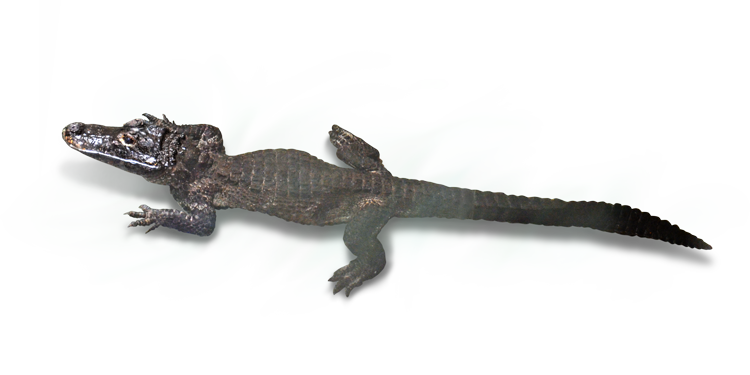
Alligator sinensis (Fauvel, 1879)
春の訪れを待つ長江の主
Awaiting Spring in the Depths of the Yangtze
全長は1.5〜2メートルほどになります。中国の長江(揚子江)下流域に生息する淡水性のアリゲーターで、アリゲーター科8種のうち7種はアメリカ大陸に分布しており、ヨウスコウワニは唯一ユーラシア大陸に生息する種です。性質はおとなしく、人を襲うことはほとんどありません。
主な食べ物はカタツムリや甲殻類、昆虫、魚などですが、まれに若い水鳥を捕らえることもあります。初夏に発情期を迎えると、雄は水中で太鼓を叩くような低音を響かせて雌に求愛します。飼育下では、プールの換水や動物舎の窓を叩く音などの外的刺激によって発情が促される例も報告されています。
冬になると、野生の個体は土の中に掘った複雑な巣穴で冬眠します。巣穴は長いもので数十メートルに達し、水辺に近い堤岸や湿地の土手を掘って、入口から水域へ通じる構造になっています。内部には寝室のほか、幼体用の部屋や浸水用のプール、換気口などが備わり、内部の温度はおよそ10℃に保たれる機能的なつくりです。
冬眠期間は約6か月に及び、その間はほとんど餌を食べません。変温動物であるため体温が外気温とほぼ同じになり、代謝が著しく低下することで、長い絶食にも耐えることができるのです。
現在、野生の生息地は中国安徽省など限られた地域に残るのみで、個体数は数百頭ほどとされています。アメリカアリゲーターと共通の祖先をもち、氷期の寒冷化によって東アジアに取り残された「生きた化石」とも呼ばれています。
The Chinese alligator grows to a total length of about 1.5 to 2 meters. It inhabits the lower reaches of the Yangtze River in eastern China. Of the eight living species in the family Alligatoridae, seven are found in the Americas, while the Chinese alligator is the only species that lives in Eurasia. It is generally gentle in nature and rarely attacks humans.
Its main diet consists of snails, crustaceans, insects, and fish, though it occasionally preys on young waterfowl. During the early summer breeding season, males produce deep, drum-like sounds in the water to attract females. In captivity, breeding behavior can be stimulated by external factors such as the replacement of pool water or sounds like tapping on windows.
In winter, wild individuals hibernate in complex burrows dug into the soil. Some of these burrows extend for several tens of meters, often connecting the entrance to nearby ponds or wetlands. Inside, there are separate chambers for resting and for young alligators, a small pool for soaking, and even ventilation shafts that help maintain a stable temperature of around 10 °C.
The hibernation period lasts for about six months, during which they eat almost nothing. As ectothermic animals, their body temperature drops close to the ambient temperature, and their metabolism slows dramatically, allowing them to survive long periods without food.
Today, wild populations remain only in limited areas of Anhui Province and nearby regions, numbering only a few hundred individuals. Sharing a common ancestor with the American alligator, this species is considered a “living fossil” that survived in East Asia after the climatic cooling of the Ice Ages.
参考文献
Smithsonian’s National Zoo and Conservation Biology Institute. (n.d.). Chinese alligator. 2025年11月8日閲覧
エコチル | 【天王寺動物園だより】春までの約6カ月間何も食べずに冬眠を「ヨウスコウワニ」| (2024年3月4日) 2025年11月8日閲覧
札幌市円山動物園 | 動物紹介 | ヨウスコウワニの繁殖-屋内飼育での環境づくり 2025年11月8日閲覧
“Chinese alligator” Crocodiles of the World. 2025年11月8日閲覧